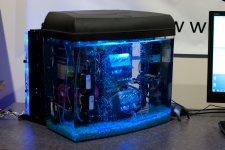Today, April 1st 2024, Learn about Puget System’s latest hardware announcement, the NEW Mineral Oil PC! Definitely real and not fake!


Today, April 1st 2024, Learn about Puget System’s latest hardware announcement, the NEW Mineral Oil PC! Definitely real and not fake!
This is going to be an unusual blog post, because I’m going to try and talk you out of one of our most impressive (and expensive) products. This isn’t the sort of thing you’d normally see on a commercial website, but I guess we’re not your normal commercial blog either. Today I’m going to try and convince you that you don’t need a fully liquid cooled system.
As a custom computer manufacturer, we’ve sold liquid-cooled systems from well before I joined the company. A water-based coolant is able to transfer heat away from hot components like the processor (CPU) and video card (GPU) more quickly than air alone would. That added cooling is appealing for folks who want to push their systems beyond design specifications. Overclocking ability is perhaps the most the most tangible benefit of liquid-cooling, but there are other reasons some folks are interested in it: liquid-cooling can make a computer look very stylish, for example, or allow operation of more hot-running components than a chassis could normally keep cool.